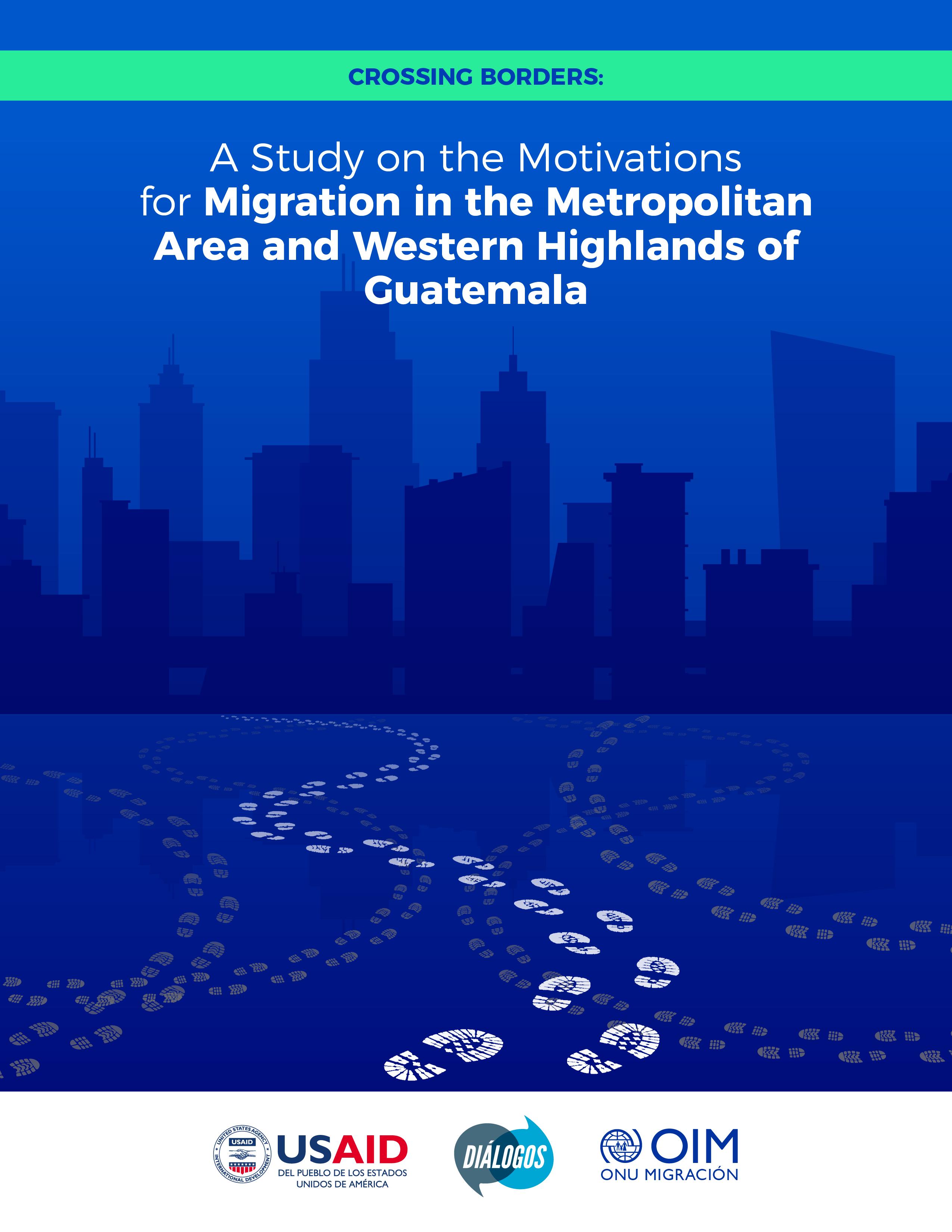

EXECUTIVE REPORT

01 Methodology










The study is based on a survey and regional focus groups. The survey was designed for two regions in Guatemala: the metropolitan area (Guatemala department) and the western highlands (departments of Chimaltenango, Sololá, Quetzaltenango, Totonicapán, Quiché, San Marcos, and Huehuetenango). The final sample consisted of 1,309 cases, of which 651 are from the metropolitan region and 658 from the western highlands. Meanwhile, the focus groups were intended to delve deeper into the most relevant findings that emerged from the surveys. The study included a factor analysis used to construct intermediate variables and indices to better understand the fundamental causes of migration. In the end, of the three indices that were intended to be constructed, only two unidimensional indices were possible to build, while the third was disaggregated into seven dimensions:1
HOUSEHOLD ECONOMIC LEVEL INDEX:


























































































MIGRATION MOTIVATION INDEX:
measures a family’s economic capabilities. Socioeconomic quintiles were constructed, where quintile 1 indicates greater precarity, and quintile 5 indicates greater economic well-being. measures the degree of inclination of individuals to relocate in search of better living conditions.
WELL-BEING AND SAFETY INDEX:
measures the level of security and well-being that individuals perceive regarding various aspects within their immediate environment.


Additionally, a cluster analysis was conducted to develop profiles of individuals based on their intention to migrate and other variables. These will be discussed later.
1 For practical purposes, from now on we will refer to it as “index,” even though it may not be unidimensional.



02 Main Findings of the Study








A. Household Economic Level Index
The socioeconomic analysis of the sample illustrates the existing inequalities related to area, ethnic group, and region:
• The percentage of surveyed households in quintile 1 (highest precarity) is greater in rural areas (37%), in the western highlands (33%), and among the Maya population (34%).
• In contrast, the percentage of households in quintile 5 (highest economic well-being) is higher in urban areas (23%), in the metropolitan region (24%), and among the Ladino/ Mestizo population (25%).





























































• There is a relationship between the educational level of the head of household and the economic position of the household. As the educational level of the head of household increases, the proportion of households in the highest quintile also increases, while it decreases in the lowest quintile. This relationship is particularly noticeable when the head of household has a university education, as 48% of these households are in quintile 5, while only 2% are in quintile 1.





























• The sources of income with the highest proportions of households in the highest quintiles are formal employment in the private sector or public sector (36% and 21%, respectively) and owning a business (26%). In contrast, households engaged in agriculture show a higher proportion in the lowest quintile (43%).


• Of the total households with a population identifying as Hispanic/Mixed-race, more than half are in the highest quintiles: quintile 4 (27%) and quintile 5 (25%). The opposite occurs with the population identifying as Maya, as more than half of these households are in the lowest quintiles: quintile 1 (34%) and quintile 2 (26%).
B. Well-Being and Safety Index
Unlike the other indices, this index was disaggregated into seven dimensions. The scale in each dimension ranges from 0 to 1, where 0 represents less safety/well-being and 1 represents more safety/well-being:
• In general, greater safety was reported in the community sphere in quintiles 1 and 2, among Maya populations and those who do not know how to identify themselves, in rural areas, and in the western highlands. However, quintile 1 and the Maya population reported less social inclusion and well-being both in the community and family spheres.
• Regarding the perception of educational and economic opportunities in the community, women have a slightly lower index than men (0.33 vs. 0.36), particularly older women, those from other ethnic groups, or those who do not know how to identify themselves, from quintiles 1 and 2, from rural areas, and the metropolitan region.
• The groups with the lowest inclusion and well-being in the family sphere are adults (0.82), the Maya population (0.82), those from other ethnic groups (0.73), and those who do not know how to identify themselves (0.81), from quintile 1, as well as residents of urban and metropolitan areas.
• The perception of staying in the community or country due to the educational, economic, and security opportunities perceived in their immediate environment is lower among young people (18-29 years), in quintiles 3 and 5, and among residents of the metropolitan area. In contrast, this index increases with age, reaching its highest value among older adults (50 or more years), who show a greater tendency to stay in their communities.
• The results reveal that men score slightly higher in almost all dimensions compared to women, particularly in the perception of economic opportunities (0.28 vs. 0.23) and safety (0.97 vs. 0.94) in the family sphere.
C. Motivation Index for Migration
The motivation index for migration measured the level of importance that respondents assigned to each reason. The scale for this index ranges from 0 to 1, where 0 represents less motivation to migrate and 1 represents more motivation:
• Women showed a slightly higher motivation index for migration than men (0.35 vs. 0.33). Additionally, quintiles 1 and 2 exhibited higher indices (0.37 and 0.36, respectively) compared to the other quintiles, while the Maya population had a somewhat higher index (0.36) than the Ladino/Mestizo population (0.33).
• Economic and employment difficulties are the most influential factors in the decision to migrate, especially for women, young people, those in the lower quintiles (1 and 2), and Maya people. Moreover, the Maya people assign greater importance to economic difficulties as a reason for migration compared to the Ladino/Mestizo population (0.65 vs. 0.58, respectively). When comparing by gender, Maya women have a motivation index of 0.68, in contrast to Maya men, who have an index of 0.63.
• Family reunification as a motivating factor for migration is more significant for men (0.32), young people (0.32), the Maya population (0.35), and people from other indige-
nous groups (0.46), particularly in the Western Highlands and rural areas.
• Regarding environmental problems, the population that did not identify with any ethnic group and the Maya population have the highest indices (0.36 and 0.37, respectively). The opposite is true for the Ladino/Mestizo population, for whom environmental issues are less important (0.18).
• Insecurity and violence as personal reasons to migrate, while less important than other factors, are more significant for the Ladino/ Mestizo population than for the Maya population (0.21 vs. 0.15, respectively) and for those living in the metropolitan area, compared to those in the Western Highlands (0.24 vs. 0.13).
• Although, on average, both men and women have a motivation index for migration of 0.19, in the dimension of insecurity and violence at the personal level, women who did not identify with any ethnic group and women from the metropolitan region recorded the highest indices (0.26 and 0.25, respectively).
• The motivation index for migration due to insecurity and violence increases when considered as a factor driving others in the community to migrate (0.31, community perception) rather than as a personal reason (0.19, personal perception). When comparing by sex, it is perceived that women in the community have a relatively higher motivation index (0.32) for migration due to insecurity and violence compared to men (0.31).
• Although cultural factors were not considered in the motivation index for migration, some comments in the focus groups referred to the search for life ideals, suggesting that there is a cultural dimension that shapes the desire to migrate.



03 Migration Profiles








The study included a cluster analysis that created four profiles of individuals who differ in their desire to migrate and other characteristics:
A. STABLE RESIDENT (73% OF THE STUDY POPULATION)
This group consists of people who have never lived abroad and have not considered migrating. It tends to be composed of more women than men (53% vs. 47%) and identifies more as Ladino/Mestizo (61%). In terms of age, individuals in this group are between 18 and 29 years old (39%) and between 30 and 55 years old (48%). In terms of socioeconomic level, they are mainly in quintiles 1 and 2 (41%).





























































It is the group with the greatest connection to their community or country due to perceived opportunities in education, economics, and security (index of 0.55); the second-highest score for family security (0.97); and the highest perception of inclusion and well-being in the community (0.92). Additionally, it has the lowest motivation index for migration (0.32).





























B. ASPIRING MIGRANT (13% OF THE STUDY POPULATION)


This group consists of people who have considered living in another country in the last year but have not made concrete plans. It is the second group in which women make up a slightly higher percentage than men (51% vs. 49%). In terms of ethnic identity, 53% of people in this group identify as Ladino/Mestizo, although it also has the highest percentage of Maya population (43%) compared to other profiles. People in this profile tend to be young, between 18 and 29 years old (56%), and belong to quintiles 2, 3, and 4 (69%). Additionally, it has the highest percentage
of people with no education (11%) or only completed primary school (38%).
Although a significant percentage of people in this group receive remittances (30%) and a smaller percentage receives social benefits (12%), it is below the proactive migrant aspirants group (described below). The main sources of income in this group’s households are informal trade, self-employment, and formal private sector work (20%, 19%, and 17%, respectively).
This group has the lowest score in community security (index of 0.73), inclusion and well-being (0.87), and staying in their community or country due to opportunities in education, economy, or security (0.36). It is the second profile with the lowest reported family security (0.92) and fewer opportunities in education and the economy. Additionally, this group has the highest score in the motivation index for migration (0.43), particularly for environmental problems, insecurity, and violence (both personal and community perceptions), as well as economic and employment difficulties. However, it has a lower score than profiles “C” and “D” in the family reunification factor.
C. PROACTIVE ASPIRING MIGRANT (8% OF THE STUDY POPULATION)
This group consists of people who have considered living in another country in the last year and have made concrete plans to do so. These individuals tend to be more men than women (56% vs. 44%), identify as Ladino/Mestizo (55%) or Maya (42%), and are young, between 18 and 29 years old (50%). They are distributed between quintiles 1 and 2 (43%) and 4 and 5 (43%). The main sources of income in this group’s households are formal private sector work, self-employment, and agriculture/animal husbandry on their own land (24%, 19%, and 16%, respectively). This group has the highest percentage of people receiving remittances (44%) and social benefits (13%). The majority of people in this group reside in the Western Highlands (58%). Compared to groups “A” and “B”, this group has the highest percentage of rural population, with 41%.
In the family sphere, this group reported lower security (index of 0.91), less inclusion and well-being than the other groups (0.80), but it was the group with the most reported opportunities for education and the economy in the family (0.35). In terms of the motivation index for migration, this group ranks second highest (0.38). Compared to the “B” group (Aspiring Migrant), it has a higher index in the family reunification factor (0.56), but a lower score in other factors. Furthermore, 57% of people in this group have family members who can help them leave the country, and 58% have friends who can do the same.
D. RESIDENT WITH MIGRATION EXPERIENCE (6% OF THE STUDY POPULATION)
This group consists of people who have lived in another country. These individuals tend to be
more men than women (77% vs. 23%), identify as Ladino/Mestizo (65%), and are adults aged between 30 and 55 years old (60%) or elderly individuals aged 56 or older (21%). In terms of socioeconomic level, they are mainly in quintiles 3, 4, and 5 (80%), and the main sources of income in their households are self-employment and formal private sector work (28% and 20%, respectively). This group reported the highest percentage in agriculture/animal husbandry on their own land (18%). Additionally, the group has a high percentage of people receiving remittances (41%), and only 7% of people in this group receive social benefits. This group has the highest percentage of people with university or higher education (28%).
In the motivation index for migration, this group has the second-lowest score, with 0.33; however, in the family reunification factor, it shares the same score as the “C” group (Proactive Aspiring Migrant), with an index of 0.56.
Conclusions
• The main factors motivating people to migrate are economic difficulties and employment issues. This is reflected in the security and well-being index, where all social groups show very low indices of educational and economic opportunities in their communities. Economic disparity is particularly noticeable between the two regions, especially in the western highlands, where 54% of the population is in the first and second socioeconomic quintiles. These conditions are closely related to the educational level of household heads and income source inequalities. Maya populations, as well as those from other towns or who don’t know how to identify themselves, are more likely to be in the lower quintiles. Therefore, the profiles of those aspiring to migrate (b and c) show high motivation to migrate in terms of economic and employment difficulties (0.77 and 0.68, respectively).
• The second factor is family reunion and remittance support. Over a third of the population surveyed has close (36%) or distant (41%) relatives in the United States, and 17% of the population receives remittances. These family and support networks are crucial for the profiles aspiring to migrate (b and c). The “Proactive Migrant Aspirant” profile stands out for having concrete plans to leave the country, which may be related to receiving more support from both close and distant relatives in the United States, who send remittances or can help them leave the country. In contrast, the “Migrant Aspirant” profile is at a disadvantage because, despite having a higher motivation to migrate, it has less support from family networks abroad.
• Environmental problems are a factor influencing migration motivation. These problems are particularly in areas where agriculture is the main source of income. This is especially true in the western highlands, where 31% of the population relies on agriculture as their primary livelihood, and 43% of this segment is in the lowest quintile. This factor was also relevant in the motivation index for both profiles aspiring to migrate (b and c).
• Social inclusion and well-being, as well as family and community violence and insecurity, significantly influence the decision to migrate. Although insecurity and violence are not the main motivating factors for migration, they make a significant difference for those who decide to migrate. For example, the “Stable Resident” profile shows a higher inclusion and well-being index in the community. In contrast, the profiles aspiring to migrate (b and c) show lower inclusion and community well-being indices. Additionally, in the family realm, the “Stable Resident” profile shows higher security than the profiles aspiring to migrate. This difference is reflected in the motivation indices for migration due to insecurity and violence at a personal level, which are higher in the “Migrant Aspirant” and “Proactive Migrant Aspirant” profiles (indices of 0.26 and 0.23, respectively).
• Women exhibit a higher motivation to migrate and a lower security and well-being index compared to men. Women have a slightly higher migration motivation index than men (0.36 vs. 0.35). This greater motivation may be closely linked to living conditions in their communities. When analyzing the security and well-being index, it is observed
that women, in nearly all dimensions, have lower indices than men, especially in perceptions of economic opportunities (0.28 vs. 0.23) and security (0.94 vs. 0.97) in the family sphere. The main motivations women consider for migrating include economic and employment difficulties and family reunion. As for why others in their communities migrate, women consider insecurity and violence to be the two most important factors. In migration profiles, women are more likely to be in the “Stable Resident” (53%) and “Migrant Aspirant” (51%) groups.
• Young people represent a higher percentage in the profiles of those aspiring to migrate. In the “Migrant Aspirant” and “Proactive Migrant Aspirant” profiles, young people aged 18 to 29 make up half or more of the population (56% and 50%, respectively). Their main motivations for migrating include economic and employment difficulties, as well as family reunion. Regarding the security and well-being index, although young people show relatively higher indices in educational and economic opportunities, and in inclusion and well-being compared to other age groups, their stay index for education, economy, and security is lower (index of 0.45).





















































































